|

Ever since Elmer and Gertrude Scheibel first opened up the place as a
northwoods resort back in 1937, Indian Trail Resort has played host to
countless numbers of fishermen and vacationers who have not only taken home
with them plenty of fish, but also many special memories over the years.
Many say that our resort has long possessed a unique ambiance that
invariably draws its visitors back year after year.
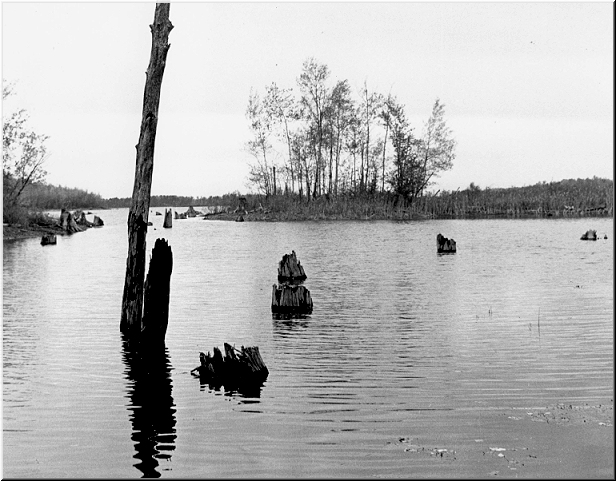
The peaceful serenity of the
Flowage has always entranced its visitors.
Perhaps it’s the Flowage’s breathtaking scenery and peaceful setting;
perhaps it’s the great fishing opportunities; perhaps it’s the special
people who make it so; and perhaps–just maybe–this distinct, magical
atmosphere that Indian Trail Resort has long been famous for is due in part
to the spirit of this place’s first and perhaps most permanent occupant… an
Anishinaabe (Ojibwa) Indian man named Chiz-ui-aw.
The Legend of Chiz-ui-aw
Even though Chiz-ui-aw has been gone now for more than ninety years, a
number of Indian Trail’s faithful guests have felt that Chiz-ui-aw has been
continually watching over his old homestead and subtly making his presence
known, often in a benevolent way… but sometimes with a touch of
mischievousness. For decades, the regulars at Indian Trail have been
spinning tales about Chiz-ui-aw, almost painting him as some kind of
mythical figure. Whether these were just stories concocted by past visitors
or they contain elements of truth, one thing is for sure… the legend of
Chiz-ui-aw lives on and he is frequently the topic of conversation in the
“Little Red Bar”.
It should be remembered, however, that Chiz-ui-aw isn’t a fictitious
character, rather he was a real man who settled upon this land long ago,
long before there were any resorts in the region and at a time when the
area’s great white pine forests had yet to be harvested.
Most likely born during the early 1850s to Chingwanakodam and Bemosadum,
Chiz-ui-aw could be considered a member of Ojibwa “royalty.” Both his
mother’s father (Gwewezensish) and her brother (O-zhaw-waw-sco-ge-zhick)
were Indian chiefs. In fact, O-zhaw-waw-sco-ge-zhick, also known as Chief
Bluesky, signed the Treaty of 1854 as Second Chief of the Lac Court
O’Reilles Band of the Chippewa (Ojibwa) Indians. In the tribal genealogy
records, Chiz-ui-aw is also referred to as Chizaian or “Indian Pete.”
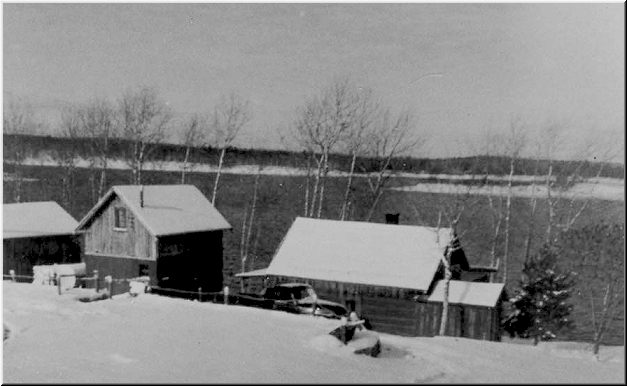
Chiz-ui-aw's original homestead
cabin, pictured right,
and the laundry (ice) house, next to it.
In May of 1881, as a result of the Allotment Act, the federal government
granted some eighty-seven acres of land to Chiz-ui-aw. It was around that
time when he built, out of hand-hewn timbers, his sturdy, sixteen by twenty
foot log cabin (now part of the main lodge at Indian Trail Resort) along the
southeast shores of Pokegama Lake, also referred to as Slim Lake by some of
the early map makers of that era. This was long before the famed Chippewa
Flowage had been created.
About a quarter mile to the northeast of Chiz-ui-aw’s cabin, located up on
the high ground, lived his half-brother, Ojawashkogijig, an Indian man who
some also referred to as “Injun Jim.” There, Ojawashkogijig had a farm and
lived in a slightly more sizeable cabin that overlooked the old Trading
Post, located just a quarter mile to the north. Chiz-ui-aw also had two
half sisters (Gijigokwe and Nigania) and another half brother (Ogabegijig,
also known as “Yankee Joe”). “Yankee Joe”, who died in 1913, lived near
where the creek that is today known as Yankee Joe Creek empties into the
Chippewa River. “Yankee Joe” was said to have fought for the North during
the Civil War, hence his nickname.
Nestled between Lake Pokegama and the big bend of the West Fork of the
Chippewa River, the Trading Post–originally an ancient Indian village called
Pa-qua-uah-wong–was one of the area’s earlier settlements. By the time
Chiz-ui-aw had built his cabin, the Trading Post was beginning to become a
hub of activity as logging gained momentum in the area. After his wife,
Bizanigijigokwe, had died in 1880, Chiz-ui-aw was left with one daughter,
Neanakwadokwe. For more than forty years Chiz-ui-aw lived at his homestead
cabin on Pokegama Lake, witnessing great changes in his surroundings through
the coming years.
By the 1920s, logging had stripped the Wisconsin northwoods of much of its
timber and most families had established small subsistence farms. With the
boom years of the lumbering days long past, activity in the Trading Post had
settled down. Many of the old stopping places that the loggers used to stay
at began to cater more to fishermen and other outdoor enthusiasts. These
places evolved into some of the area’s first resorts.
|
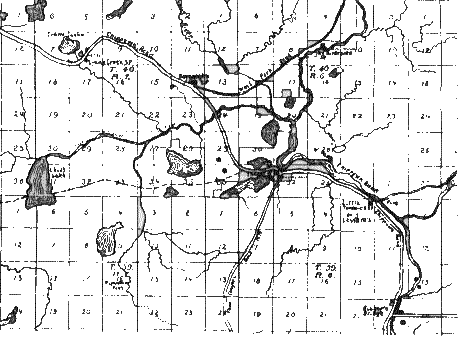
An 1880s map showing the area
where the
Chippewa Flowage today is located. |
In 1923, a dam was to be constructed on the Chippewa River about
five miles downstream from the Trading Post. The huge reservoir
that resulted -- the Chippewa Flowage -- flooded not only over
ten-thousand acres of land, but also most of the old Trading Post as
well as many people’s homes. Although Chiz-ui-aw’s cabin was built
up on high enough ground to be spared, the prospect of such a
monumental change about to affect his surroundings must have been
hard for him to accept. |
However, Chiz-ui-aw never did live to see it because, not too long before
the Flowage had been formed, on November 1, 1922, Chiz-ui-aw drowned out in
front of his cabin. Perhaps he was out trapping, hunting, or fishing at the
time. Or perhaps he was just out paddling around to survey his home waters
and taking in all of its peaceful splendor before “progress” would change it
all forever. Shortly after Chiz-ui-aw’s death, the waters of Pokegama froze
with the coming winter… never to be seen again in their original state. By
the time the spring thaws came the following April, the flood had already
begun and the new flowage was born and growing. In essence, in what can be
considered a poetic death, both Chiz-ui-aw and the waters he had known for
so long ended up dying together… as if they were one.
It must be said that the resulting Chippewa Flowage is no less serene; it’s
just different than it was back in Chiz-ui-aw’s time. In fact, because many
decades have allowed a beautiful second growth to reforest what the loggers
had taken away more than a century ago, today the Chippewa Flowage stands as
one of the most scenic and pristine bodies of water in the country. This
largely unspoiled wilderness has but slight development and is loaded with
all types of fish and game: offering excellent crappie and walleye fishing,
great bass fishing, and some of the finest musky fishing in the world.
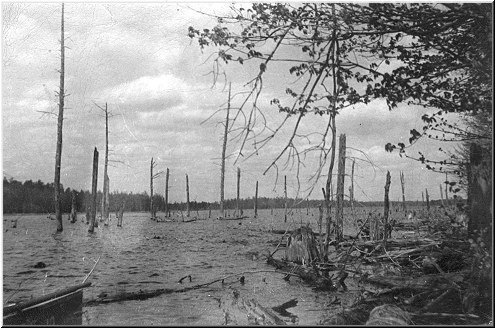
There was much standing timber in
the Flowage years ago.
In retrospect, while sitting right here in the heart of Chiz-ui-aw’s cabin
as I am writing this history, I can’t help but think of him and hope ...
“that even Chiz-ui-aw would approve of how we have caretaken this land.”
Before Chiz-ui-aw’s descendants inherited this land, his cabin was left
abandoned for a time. It has been said that some visitors to the cabin at
that time witnessed movements that they believed were made by Chiz-ui-aw’s
ghost. From that day on, the legend was cast that Chiz-ui-aw’s spirit was
watching over his old place.
The Birth of Indian Trail Resort (the Scheibels)
After changing hands a few times, in May of 1937, Chiz-ui-aw’s homestead was
purchased by Elmer and Gertrude Scheibel of Beloit, Wisconsin. Scheibel,
who grew up out West, originally wanted to be a cowboy and live in Wyoming.
When World War I began, however, Elmer joined the Navy and served as a cook
on a troop ship. After the war, Elmer opened up Scheibel’s Market where he
gained much experience as a meat cutter.

The original owners
of Indian Trail Resort, Elmer and Gertrude Scheibel, pictured around
1940 with their daughter Jeannine, standing outside the entry to the
original tavern, which later became the resort's dining room.
Tough times brought on by the
Depression, caused the Scheibel’s to leave Beloit and make the big move to
the remote northwoods, near New Post, Wisconsin, to purchase an old Indian
homestead on eighty-seven acres of land and turn it into a resort.
Because there was no road to the place, the Scheibel’s had to use Billy
DeBrot’s Indian Post Resort (located about a mile and a half away) as their
jumping off point, taking a boat across the lake to get to their property.
Upon entering Chiz-ui-aw’s cabin for the first time, Elmer and Gertrude
found it to have a mud floor and only one room. Although Chiz-ui-aw had
been dead for fifteen years by then, there were still many of his herbs and
a lot of tall, beautiful wild flowers growing outside the cabin. Chiz-ui-aw,
a medicine man of sorts who was known as “Indian Pete” to the Scheibels,
used these plants for various remedies and was known to make a kind of tea
out of the sumac plants that were growing nearby.
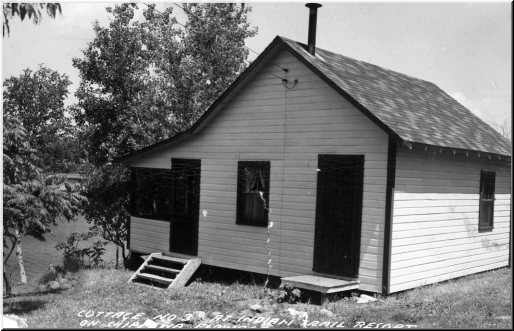
One of Indian Trail's original
cabins, built around 1937.
With Chiz-ui-aw’s original log cabin being as much as fifty-six years old
but still acting as a sound structure, Scheibel divided the one-room cabin
into two separate rooms and built a large windowed porch onto the lake side
of the cabin. This not only expanded their living quarters, but also would
serve as the perfect spot to establish a tavern for his guests during the
summer months.
Another important task that Elmer immediately saw to was to dig a well so
that his family could have fresh drinking water. Being subjected to such
Spartan living conditions was quite a culture shock for Gertrude Scheibel,
who was accustomed to having all the modern conveniences in her home. With
their only water supply coming from a large, hand pump at the well outside their
cabin, Gertrude had to learn how to “take a bath out of a teacup” as she put
it.
With the help of a Swedish carpenter named Oscar Hanson who lived across the lake, Scheibel
then built three two-bedroom cabins, complete with large screened-in porches
overlooking the lake, about fifty feet from the water’s edge. Because there
was still no road into the place at the time, all of the lumber that was
used in the construction of the cabins had to be floated in across the lake,
from Billy DeBrot’s resort. Built up on concrete pillars to compensate for
the hilly terrain of the grounds, these now seventy year old cottages are
remarkably well preserved because sufficient air circulation underneath them
has prevented any real deterioration from ever occurring. Because most of
the land along the lake had been clear cut, Elmer worked hard planting trees
along the lakeshore of the resort.
Because there still was no road into their place during that first year,
there wasn’t much business that season. In order to give the tourists a
more convenient access to the resort, Scheibel decided that he needed to get
a road put in to his place. Because he couldn’t get much cooperation from
the local township to put in a road, Scheibel took it upon himself to survey
the route of the new road, cut the trees, and hired some local INDIANS to
drag more than a mile long TRAIL through the woods from Helsing Road to his
new RESORT… hence the name INDIAN TRAIL RESORT. Henry LaRush was one of a
number of local Indians who helped Scheibel blaze the trail to his resort.
As with most northwoods camps at the time, instead of having refrigerators,
the cabins had ice boxes that had to be kept stocked every day with fresh
blocks of ice. The ice was stored in an ice house, located in a small,
two-story building that Elmer had built right next to the main lodge. The
cabins each had their own outhouses and were heated by wood stoves, so
keeping a ready supply of wood was also one of the many daily resort chores.
There was no electricity here until the late 1940s so a generator, housed in
a small shed near the main lodge, was installed to satisfy only the resort’s
most basic electrical needs. Even so, much of the lighting for the cabins
was still being provided by lanterns and water for the cabins was taken
right out of the lake with pails.
The Scheibel’s only daughter, Jeannine, was around eight years old when her
parents established the resort. Reminiscing about her unique life and
adventures at the resort, Jeannine said, “It was one of the greatest
loves I’ve ever had.” Having countless fond memories about the
resort, Jeannine recalled:
“There were many good times that were had at the bar on our
porch when the lumberjacks would come down out of the woods. One of them even had an accordion and would play music for
the group. The bar’s front had a beautifully arranged log design with a
specially carved, diamond shaped, log in the center. Behind the bar
were shelves where we would stock groceries for our guests. I used to
sell live bait out of a dugout area that was located underneath the
porch (bar).
Fishing was very popular back then; the guests couldn’t get enough of
it. There was some great walleyed pike fishing; the crappie were huge;
and many big muskies were caught. My father guided quite a lot and we
used Tony Crow, an able Indian guide, as our resort’s leading guide.
Back then, money had less importance and people often bartered to
transact business. Because my father was known to be a skilled meat
cutter, it was common for the Indians to kill a deer and drag it all the
way across the lake on the ice just to have him butcher it. Naturally, our family
would be given a portion of the meat for his work. The Indians often
gave us wild rice and wild blueberries, which we greatly appreciated.
One time, after some Indians had killed a deer off reservation, near the
main road, and were dragging it home, they were startled when they
noticed a big limousine come speeding up. At first being worried that
it was the authorities, the Indians remained apprehensive when some of
Al Capone’s men got out of the car and inquired about the deer. The men
ended up buying the deer from the Indians and having my father butcher
it for them. They even invited my parents over to Al Capone’s hideout;
however, because I was just a young girl, I wasn’t allowed to go. It
was the only time I was ever excluded from something.
I went to school in a one room school house in New Post, where students
through the eighth grade were taught by one teacher. There was a big
stove in there to keep us warm during the cold, winter months. All of
the children really helped each other out at the school, with the older
children always helping out the younger ones.
I had many good friends in New Post and we enjoyed many adventures
outside. I can remember how one of my friends, Henry LaRush’s son,
would always go barefoot, and because I wanted to prove that I was just
as tough as him, I decided to go barefoot all the time too. I used to
like to explore the old, abandoned Indian home (owned by Chiz-ui-aw’s
half brother, Injun’ Jim) that was located between our last cabin and
the creek to the east. The cabin was fully intact and had a big,
beautiful bed inside that the animals had ravished over time.
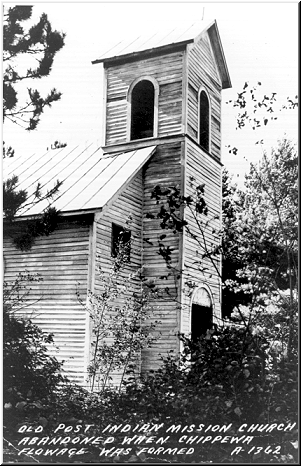 I would also row over to the old Catholic Church on the island across
the lake and go inside and explore it. It was a large, white sided
building, decorated beautifully with ornate wallpaper that depicted the
lamb and the cross. Outside the church were grave stones all over,
including many off shore under the water. The Indian kids would often
go diving there to try to read the names on the tombstones. I would also row over to the old Catholic Church on the island across
the lake and go inside and explore it. It was a large, white sided
building, decorated beautifully with ornate wallpaper that depicted the
lamb and the cross. Outside the church were grave stones all over,
including many off shore under the water. The Indian kids would often
go diving there to try to read the names on the tombstones.
One of the scarier times that I remember occurred during the summer of
1939, when a fugitive killer (Ray Olson) was at large in the woods
around the Flowage for a week or so. I can remember lying awake on my
cot at night, starring out my window at the stars and feeling like the
fugitive was out there… looking in my very window. I later learned that
the man was tracked down by a large posse and shot repeatedly as he was
trying to escape. I think the mood of the citizens had gotten out of
hand by that time, the way things had turned out.
We had quite a few relatives and as soon as they found out we had a
resort, they decided that this would be a good place to stay. So they
kept us pretty busy. One time when many of them were there, it was
during August of 1941, I can remember there being a giant storm and a
big flood. It rained and rained and rained until more than thirteen
inches of rain had fallen and the lake had risen two feet in one day.
It caused a huge washout of sand on the hill, blocking the road that my
father had blazed and causing everyone to remain stranded at the resort
for over a week.”
During World War II, business slowed at the resort so Elmer Scheibel was
forced to log off much of the back acreage of his property, selling lumber
for the war effort to make ends meet. For this task, Elmer rented a horse
from a man in Radisson and kept the horse in a shed that he had built up on
the hill above his cabins, near where he maintained a garbage dump. He
would use the horse to drag the logs out to the road, where they could be
hoisted onto a truck and hauled away. Although Elmer fell in love with that
old swayback horse that he had, it hurt him to have to cut down the “perfect
pine” that was growing on his land.
Once Jeannine Scheibel was of high school age, the family had a decision to
make. If they were to stay on and live at the resort, Jeannine would have
to be sent away to a boarding school to continue her education. They didn’t
want that for her, so the Scheibel’s regrettably decided to put the resort
up for sale.
It was at that time when a man named Edward Bosch, who ran a Pontiac
dealership in Hales Corners, Wisconsin, approached the Scheibels to see if
they would sell him the west half of their property so that he could build a
summer place on the lake. Not wanting to sell only half the place, Scheibel
told Bosch that he would have to purchase the whole place if he wanted that
land. Not really wanting to get into the resort business, Bosch didn’t want
that land to slip through his fingers however… so he ended up buying Indian
Trail Resort in June of 1944.
Making Cabin #1 his temporary home during that summer, Bosch then had Don
and Mary Hendee manage the resort–with an arrangement for them to buy out
the resort at the end of the season–while he built a beautiful, log cabin
overlooking the Flowage. Keeping the western half of the parcel for
himself, Ed Bosch then sold the Hendees the resort half of the property that
fall.
(The Hendees)
It was in September of 1944 when Don and Mary Hendee bought Indian Trail
Resort. Don, who worked in the Freeman Shoe Factory in Beloit, Wisconsin,
was in poor health so he decided to move up to the serenity of the
northwoods to escape the hustle and bustle of city life.
It
was during the fall of 1945 when Don Hendee, his brother, Arnold (who had
just gotten out of the service following the close of World War II), a
relative named Al Loomis, and two local Indians named George Thayer and
Clyde Miller built the “Little Red Bar.” They did so by tunneling
underneath both the porch that (up until that time) had served as the tavern
and Chiz-ui-aw’s original cabin. Clyde Miller dug most of it out with a
horse and a plow blade and the rest was done by hand, with shovels. Thick
log beams were installed to support both the porch and Chiz-ui-aw’s cabin
and the Red Bar’s walls were constructed with large stones that were
cemented together by Loomis. After Loomis and company constructed a large,
walkout, pipestone patio overlooking the Flowage, the project was completed…
and the “Little Red Bar” was born.
The old porch tavern then became a dining room. Around 1946, the Hendees
built their fourth rental cottage, a two-bedroom Log Cabin that also had a
roomy screened in porch overlooking the lake. The beautifully varnished,
dark stained logs on the inside of the Log Cabin truly make this cottage
unique and, to this day, it stands as one of the first cottages to be
requested.
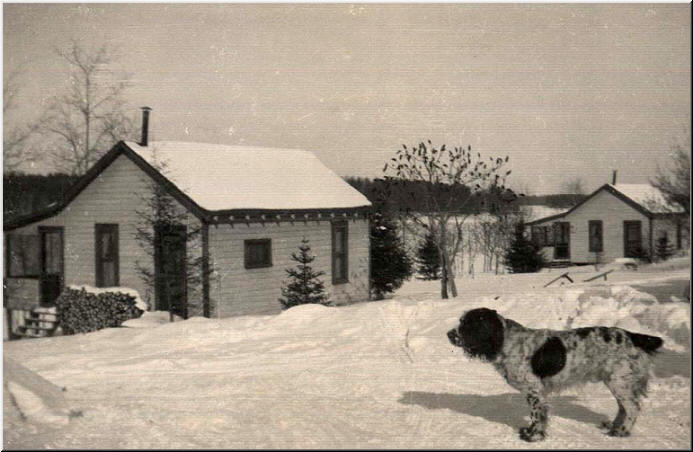
Cabins #1 and #2 at Indian
Trail in 1948.
The resort also had a small, one-bedroom cabin that was located between
Cabin #1 and Cabin #2. Originally, this cabin served as an occasional
sleeping quarters for the Indians who worked at Indian Trail; however,
sometime in the 1940s it was moved up closer to the road and then remodeled
by Loomis so it could be used as an additional rental unit. It came to be
known as the Honeymoon Cabin until it ceased being rented out in the 1960s.
 |
Don Hendee holding a big musky from the 1949 era by a shed that
use to be located where the Bunkhouse is currently.
|
|

The old ice house at
Indian Trail
during the 1940s. |
Don Hendee’s nephew, Bob Loomis, has many fine memories of working
for his uncle at the resort when he was a teenager.
During the winter, Bob recalled, “Blocks of ice were cut from the
frozen flowage out in front of the resort. To cut the ice: a
three-foot diameter saw blade was attached to the rear axle of an
old truck and, after driving it slowly, a long cut could be made in
the ice. Once blocks of ice were cut out of the lake, the heavy
blocks were pulled up from the frozen lake to the ice house by being
winched up to the building on a long wooden slide. The blocks were
then lifted off the slide with a pulley system and swung around into
the ice house. The ice blocks were then covered up with tarps and
sawdust so they could keep through the summer. After electricity
came to the resort, the old ice house was converted into a laundry
house.” |
Bob Loomis remembers all too well the old ice house at the resort because
this was where his sleeping quarters was… in the loft area directly above
where the ice was stored. Naturally, even during the hottest summer days it
was always cool up there.
Even though Bob had the loft to himself during his summers at the resort, he
sometimes felt like he wasn’t completely alone up there. For late at night,
he would sometimes hear strange noises and sounds in that old ice house.
Although he had never personally seen any aberrations while he was there,
Bob was well aware of the stories of the old Indian (Chiz-ui-aw) that used
to live on the premises and had wondered if that couldn’t have been who it
was. Not really worried though, Bob knew that Chiz-ui-aw was known to be a
good ghost and just reasoned that, “If it was indeed Chiz-ui-aw, he must
have been just watching over the place”.
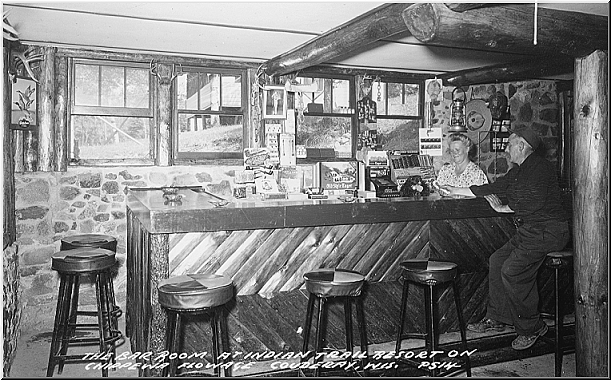
Don and Mary Hendee in the
bar in the 1940's.
As choreboy, Bob Loomis’s duties included keeping the resort’s ice boxes
stocked with fresh ice, doing a variety of outdoor work, guiding (the Indian
guides had taught him everything he knew), and getting up at five or six in
the morning to fire up the lodge kitchen’s eight-burner, wood cooking
stove. George Thayer’s wife, Margaret, served as Indian Trail’s cook,
preparing breakfast, lunch, and dinner to be served in the dining room. For
years the Thayer’s worked at Indian Trail, with George guiding and helping
with resort maintenance and Margaret cooking until 1959.
Bob’s grandfather, Al Loomis–a retired Beloit fireman, contractor, and
carpenter–lived at the resort during the Hendee’s first few summers there
and was responsible for most of the major improvements during those years.
Don rounded up all the materials and the help… and Al did the work. Much of
the time the resort was filled just by relatives of the Hendee and Loomis
clan, and sometimes it was so busy at the resort that people would have to
sleep on the cabin floors and the overflow pitched tents and slept outside…
under the stars.
During the
fall of 1949, Don Hendee and local workers Chick DeBrot and John Bennett
began to notice a familiar boat spending an inordinate amount of time
fishing across the lake, near where the old Trading Post used to be. The
same boat kept fishing the same area, every day, several times a day, during
the first three weeks of October. The weather was exceptionally warm during
most of that period; however, on October 20th, the weather made a turn for
the worse. Never-the-less, even though it was cold, windy, and nasty, just
like clockwork, that same boat was again out there fishing. But this time
they decided to take a break and stop in at the Little Red Bar. In walked
Louie Spray with his two fishing companions, George Quentmeyer and Ted Haag.
After warming up, the trio went back out there and resumed fishing.
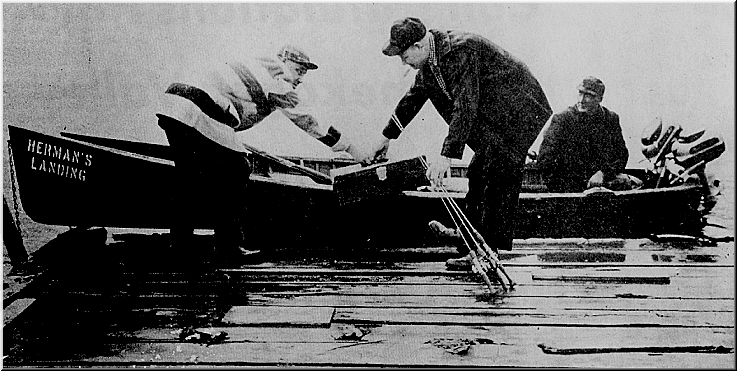
Louie Spray and companions
getting ready to go out fishing in 1949.
Spray was fishing near Graveyard Point when Hendee, DeBrot, and Bennett
heard a commotion and a lot of hollering over there. A couple of gunshots
alerted them to the fact that Spray had just taken a decent musky out there.
The next time Spray came by, he confided in Hendee and asked, “Did you
hear some shooting out there the other day? Well, I got the big one there.”
That BIG ONE happened to be the world record muskie of 69 pounds
11 ounces!
(The Hornewers)
In 1952, Ed and Elsie Hornewer and Axel and Grace Christensen purchased the
resort. Because their husbands kept their jobs in Chicago and were
committed to working there during the week, for the most part, the resort
was run by the two sisters, Elsie and Grace. On the very first day that
Elsie and her family moved into the resort, Elsie recalled that she noticed
three Indians standing outside her porch. Being from Chicago and never
having seen an Indian before, Elsie got scared, thinking that these three
“characters” must have been up to no good. However, she quickly discovered
that they were frequent workers for the resort and they had just come to
introduce themselves and see if there was any work available.

Elsie Hornewer, owner of Indian
Trail from 1952 thru 1962,
behind the bar in the 50s.
Elsie soon warmed up to the trio (Earl “Chicken” DeBrot, Henry “Turkey”
Potack, and John Bennett), giving them a variety of odd jobs over the years
and becoming great friends with each of the men. They always kept a close
eye on the resort for Elsie–especially when it was closed for the season–and
they were always well taken care of for their services, being paid in money,
groceries, and, on occasion, even liquor. And when it came time for Elsie
to buy a new fleet of wooden Badger boats for the resort, she gave “Turkey”
Potack the pick of taking one of the older boats for himself. After that,
Elsie always said that he was so proud to own his own boat.
Elsie and Grace’s first big addition to the resort was in 1953, when they
had a new three-bedroom cottage built. The roads were so poor that the
lumber they needed to build that cabin with had to be both hauled and
floated in by boat. Charley Wolfe, a local Indian from New Post who often
guided for the resort, helped to build this cabin.
In 1958, Grace and Axel wanted out of the resort so they sold their interest
in the place to Ray and Evelyn Hornewer. However, that didn’t work out so
after that season, Grace ended up getting the resort back. For some reason
she didn’t want to sell her half of the resort to her sister Elsie so she
“gave” it to Jim Schoettle, a young man who had been helping out at Indian
Trail for a number of years, telling Jim that he could pay her when he gets
the money.
Knowing how much she loved running the resort, Jim was hesitant to accept
the offer but Elsie, who not only needed the help but thought the world of
Jim, told him, “You take it; I couldn’t imagine having a better
partner.” So from 1959 thru 1962, Elsie and Jim Schoettle ran the
resort together.
|
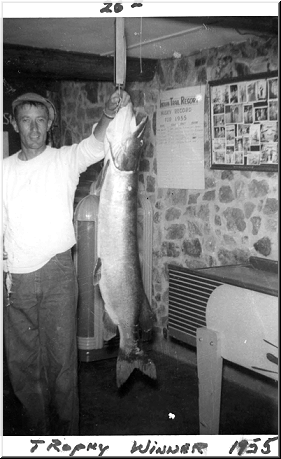
Musky legend, Frenchy
LaMay was one of the resort's most prominent guests. |
During those years, the living quarters in the main lodge was greatly
expanded when a second floor was added; thereby, totally encapsulating
Chiz-ui-aw’s cabin within the main lodge building.
Also, the laundry house (ice house) and a nearby tool shed were joined
together and made into one long building called the Bunkhouse, offering stag
fishermen simple, inexpensive accommodations.
At first, the Bunkhouse was just one large room with a number of cots set
up, but it wasn’t long before it was partitioned into individual sleeping
rooms, offering lodging for up to eleven men.
From time to
time, it was believed that Chiz-ui-aw would return… especially whenever
something odd or unexplainable would happen. One such occasion took place
in 1955, when some guests who had just checked into Cabin #2 parked their
new red and white ’55 Chrysler on the road up above the cabin. |
|
They were in
the bar when they suddenly learned that their car had just gone into the
lake–all by itself–disappearing over the bank into twenty feet of water!
While it may be quite possible that the car could have simply rolled down
the hill on its own, the gauntlet of trees, bushes, and other natural
obstacles that the car had amazingly dodged on the way down convinced many
at the resort that “other forces” must have been at work and just maybe… Chiz-ui-aw had taken that car for a joy ride.
From 1963 to 1968, Howie and Wanda Hornewer owned Indian Trail Resort.
During their first season (1963), Elsie stayed on at the resort to
show them the ropes. |
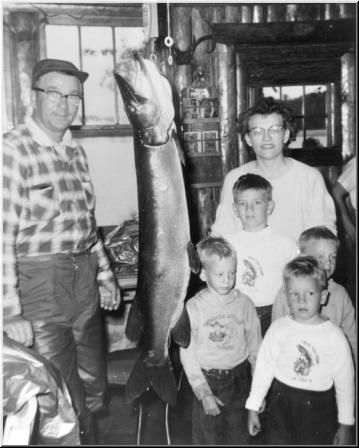
Walter J. Roman &
family with
a nice musky in 1956. |
That year, Jeanne Christopherson worked with Elsie,
cleaning cabins and assisting her in the kitchen and dining room during
mealtime. Prior to this, Elsie had a number of Indian girls (Rose Thayer,
Connie Tainter, Sirella LaRush, and Deanna DeBrot) work for her as kitchen
and dining room help. Just like her father, “Chicken” DeBrot, Deanna become
somewhat of a fixture at the resort: cleaning cabins, tending bar, and even
baby sitting when needed.
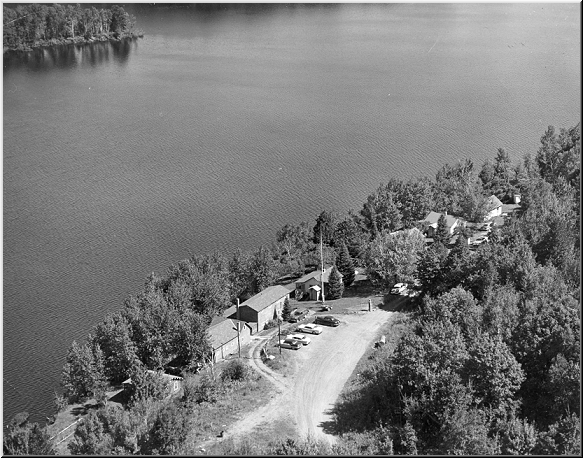
Indian Trail in the early 1960s.
|
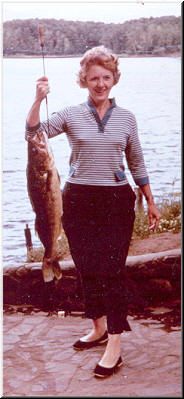
Evelyn Hornewer
pictured with her son Billy's 13# walleye
in 1963. |
In September of 1963, the largest walleye ever caught out of Indian
Trail was taken: a 13¼# beauty caught by Billy Hornewer while musky
fishing with a Pflueger Globe.
With
Howie continuing to work full time for the Chicago Tribune
during the five years that he owned the resort, he left the running
of the resort during the week to his wife and father, Steve
Hornewer.
In
terms of taking care of all the needed maintenance that had to be
done, Steve, who was always welcoming to his guests, was the glue
that held the resort together during those years
Howie’s schedule was very tight and he would race back to the resort
nearly every weekend to help out. More than once after one of his
marathon drives back to the resort from Chicago, after work on a
Friday, Howie would be caught nodding off behind the bar. |
The standing joke with his customers who wanted a drink was that they would
have to wake him up to get a drink.
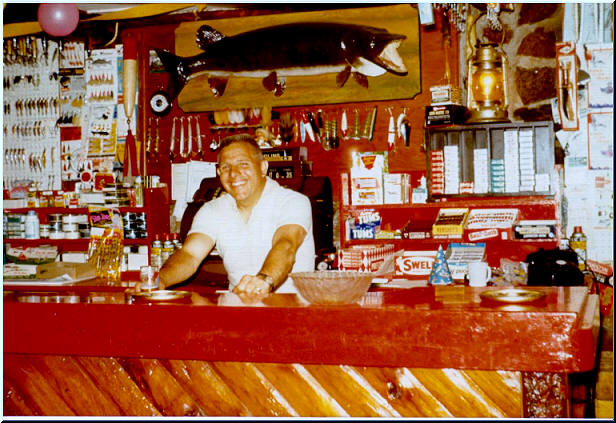
Howie Hornewer, behind
the bar, owned Indian Trail from 1963 thru 1967.
In 1964, after “Turkey” brushed out the thickets just beyond the resort’s
last rental cottage, the Hornewers added an additional rental unit to that
site: a large, modern mobile home. Even so, with five cottages, the
Bunkhouse, and the new Mobile Home still sometimes being inadequate to meet
the demand of all those who wanted to come up and stay at Indian Trail,
Howie and Wanda began allowing some of their regular guests to park small
travel trailers along the road between the parking lot and the old honeymoon
cabin. By 1967, the five trailers that were scattered about were beginning
to crowd things, so Howie then cleared out some land up the hill above the
cabins and opened a small trailer court, which now has twenty-three
trailers.
While continuing to serve full American plan meals in their dining room, the
kitchen at Indian Trail remained a very busy place for Wanda each day during
meal times. During the mid to late 1960s, a teenage girl from Poland called
“Boosha” boarded at the resort and baby sat for Wanda, later going on to
working in the kitchen and also taking care of domestic (cabin cleaning)
duties.
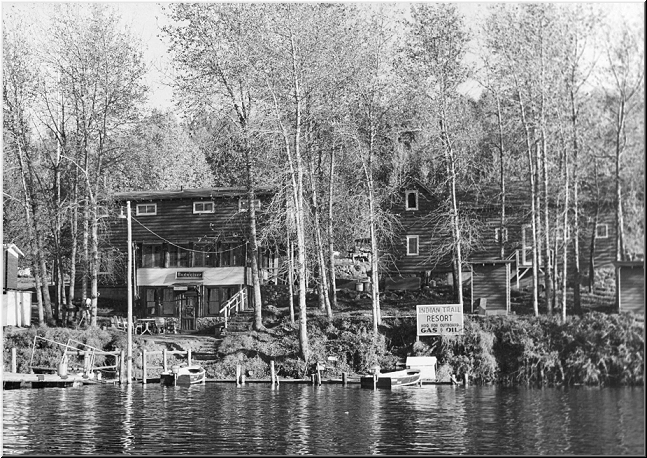
The main lodge and Bunkhouse at
Indian Trail in the early 60s.
(The Wilmsens)
After five years of running the resort without Howie being able to be there
full time, the Hornewers decided to sell the resort. After finding out that
Indian Trail was for sale while they were there on their summer vacation in
1967, Ron and Pat Dettloff considered buying the place but declined because
they weren’t yet ready to make such a move. However, Pat’s brother, Lee
Wilmsen, who was also on vacation with them, was ready for such a change.
So late in 1967, Lee Wilmsen bought Indian Trail Resort and operated it for
the next four seasons.

Lee Wilmsen owned Indian
Trail from 1967 thru 1971.
Lee, who was recently divorced and had four young boys, quit his job at the
Campbell Soup Company in Chicago, sold his house, and–along with his parents
(Peter and Pauline Wilmsen)–moved up to the resort in April of 1968. Peter,
the congenial fatherly figure who was very much the counterpart to old Steve
Hornewer, took charge of collecting, sorting, and burning the resort
garbage; mopped the cabin floors; cleaned out the outhouses; bar tended
during the afternoons; and also acted as Lee’s ever present project
consultant and “assistant handyman.” An easy going kind of guy, Pete once
disappeared after being sent to clean a cabin. He was found on a cabin
porch relaxing in an easy chair, fast asleep with a beer in his hand, as the
peaceful sounds of the waves had put him into his own little dreamworld.
|
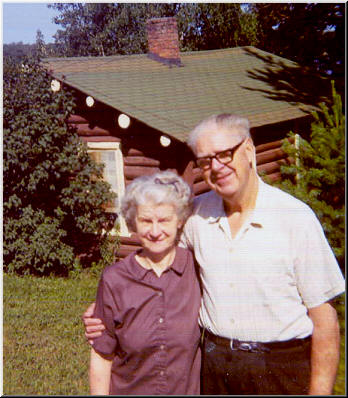
Pete and Pauline
Wilmsen, pictured in front of the Log Cabin, around 1968. |
Lee’s mother, Pauline, however, was a working dynamo. Maintaining
primary control of the kitchen and co-directing the cabin cleaning
operations with Lee, Pauline was a key player in the running of the
resort.
Serving breakfast, lunch, and dinner in the dining room seven days a
week, Pauline and her help (which often included her grandsons)
punctually served up many a hearty meal to the guests.
Lee would take over the kitchen twice a week, however, making steak
one night and chicken another night.
Meanwhile, Lee oversaw the overall operation of the resort and
served as the primary barkeep for the notoriously wild party crowd,
for which the “Little Red Bar” was famous. |
Lee and some of his regular patrons often had some kind of wager or contest
going between themselves when it came to playing the antique bowling game in
the bar. One particular night, they were playing for 6-packs of beer and
one of the guests (Dick Hansen) confidently bragged that he was going to
clean Lee out of his entire stock. Although he didn’t think it was
possible, sure enough, Lee ended up losing every 6-pack in the place to his
guest. Lee had to haul out every 6-pack of beer he had and stack it right
there in the middle of the bar floor to pay his “gambling debt.”
Just then, a thirsty, late night patron came in asking for a 6-pack of beer
and Lee had to sheepishly direct him to purchase the beer from his guest.
After Hansen reveled in his victory for awhile, he graciously returned all
the beer to Lee (who needed it to stay in business) and settled on a lobster
dinner as a consolation prize.
Lee started one of the Indian Trail’s most important traditions during his
first season at the resort when, in 1968, he installed the musky siren on a
tree high above the patio. From that point on, every time a person would
come in with a musky, this air raid siren would be sounded to alert not only
everyone at the resort but also anyone on the lake within a three mile
radius. Years ago, before catch and release started, any musky brought in
would be prominently displayed in the bar, hanging from the official weigh
in scale. It always was quite exciting for the guests to come in and see
how big the musky was.
|
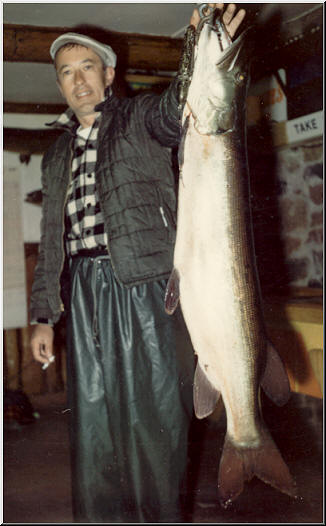
Frenchy with a 22#er
caught in 1969 with a Krackle globe still in its mouth. |
During the four years that Lee had the resort, he expanded the
trailer court as his regular guests began requesting spots up on the
hill.
Lee’s first order of business after he bought the resort was to coax
Frenchy LaMay into moving his trailer to Indian Trail. Herman’s
Landing–where Frenchy had been keeping his trailer for a number of
years–had to close their trailer court, so Frenchy was forced to
move his trailer to another resort.
Formerly a guest at Indian Trail during the 1950s, Frenchy was quite the
character and had quite the reputation as a successful musky angler.
Much
in the same way that a country club will entice a golf pro into playing on
their greens to bring more notoriety to their club, Lee knew that Frenchy’s
association with his resort would also further solidify Indian Trail
as a musky fishing camp.
With a number of his old fishing buddies being
regulars at Indian Trail, Frenchy welcomed the invitation and promptly moved
his trailer there. |
Combined with the musky men who had already been cottage regulars, Frenchy
and the additional fishermen who put trailers in at Indian Trail made for a
solid contingent of musky anglers. Even so, Frenchy–who was on the top of
his game at the time–remained the dominant musky producer at the resort for
the next six years.
While time has had a way of marching on over the years, the gang at the
“Trails” always made sure that the old days and Chiz-ui-aw would not be
forgotten.
Over 50 years ago, Jackie Hollen, one of the resort’s Indian
guides, began honoring Chiz-ui-aw by tossing him offerings of candy or even
pennies off the dock… in hopes that Chiz-ui-aw would reciprocate by allowing
him a good day’s fishing.
Yes, scores of superstitious fishermen have since
continued the tradition and often seek Chiz-ui-aw’s guidance.
Evidently continuing to watch over the folks at Indian Trail, some believe
that it was Chiz-ui-aw who intervened when Pete Petrouske nearly killed
himself in what could have been a serious boating accident at the resort’s
main dock.
Petrouske, speeding in with his boat, suddenly had the throttle
of his motor stick at full speed as he was approaching his dock slip. At
the last minute, he somehow managed to turn his boat to avoid crashing into
the dock; however, he then found himself heading straight towards a small
bridge (with barely two feet of clearance beneath it) that connects to the
floating dock.
At the last second, Pete ducked his head to avoid decapitation as his boat
shot under the bridge. Upon emerging from the other side of the bridge,
Petrouske’s boat then careened off the rear end of Frenchy LaMay’s boat just
as he and his cousin, Warren Schreiber, were backing out to go fishing.
The main project that Lee tackled at the resort was to build a large, three
car garage in the main parking area in 1970. It was around that time when
Pauline had a mild heart attack, an occurrence that necessitated cutting
down on the grueling kitchen detail that was a big part of her duties.
Lunches were eliminated and dinner service was cut back to primarily include
just the Bunkhouse patrons who had no cooking facilities to use.
With his parent’s involvement in the resort becoming more limited with each
year, following the 1971 season, Lee decided it was time to sell and move
onto a meat business venture that he had been thinking about for some time.
(The Dettloffs)
|
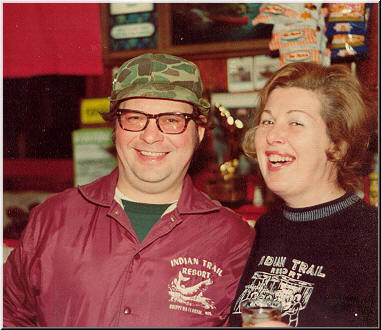
Ron and Pat Dettloff
owned Indian Trail together from 1972 thru 1983. |
In the spring of 1972, Lee sold the resort to his sister Pat and her
husband Ron Dettloff and moved two blocks down the road and started
up Lee’s Smokehouse, a wholesale/retail custom meat business. The
first year at the resort, Ron was like a kid in a candy store,
fishing with a vengeance and having quite a successful musky
season. The following year, 1973, was the best musky year the
Flowage had seen in nearly twenty years. Frenchy LaMay sure hit on
a hot streak that season, catching a 40 pound class musky that
brought even more notoriety to the resort. |
|
Pat, a natural at promotion, ran with this and made sure that every
publication in the Midwest knew about the banner year that the
Flowage–and Indian Trail Resort–had experienced.
And with each successive fishing bonanza that came during the coming
years, Pat was right there in the forefront as the lead cheerleader
in the musky arena, telling the world what great fishing could be
had while fishing out of Indian Trail.
This news attracted even more hard core musky anglers, many of whom
fell in love with the Flowage and also became “part of the family”
at Indian Trail.
Along with some great walleye and crappie fishing and an explosion
in the Flowage’s smallmouth bass fishery during the late 1970s, more
muskies and bigger muskies were caught each year. |
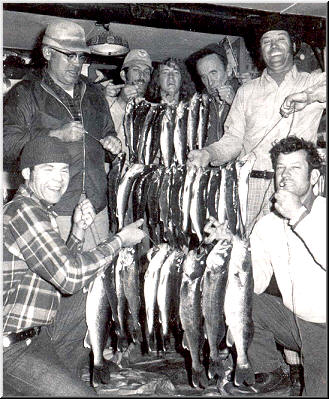
May Walleye
Bonanza from 1975. |
It seemed as though new musky records were set each year at Indian
Trail.
Ron and Pat ran the resort together until 1984, when they divorced amicably,
and their son, John, bought into the resort. During those years, John
developed into one of the most successful musky fishermen on the Flowage,
carrying the torch of promoting the love of the sport even further than the
musky men who preceded him had done.
The “Little Red Bar” continues as the social center and the place where the
fishermen can either plan their next day’s strategy or just swap stories.
Here, they still fight fish that were caught or lost more than 50 years
ago. John, a dedicated musky fisherman, has always been quick to share a
story or two with his patrons.
However, sometimes the stories are put on hold for a while, like when a
happy guest comes in with another great catch or maybe when a mysterious
(but familiar) visitor makes a surprise appearance. Such an event occurred
back in 1984, when, in mid-story, John was interrupted by a mysterious wind
that, even from the wrong direction, still managed to blow the heavy, log
door of the bar open… and then bang it shut. The place became as silent as
a cemetery for a few moments until John offered a quick explanation to the
bewildered fishermen. “That was just Chiz-ui-aw. He wanted to come in
and visit.”
A prime
example of how much influence that Chiz-ui-aw can have on a person’s fishing
success is illustrated by the saga of Al Denninger, a serious musky angler
and fishing guide. At first, whenever Denninger heard the gang at the
“Little Red Bar” talk about how making an offering to Chiz-ui-aw could
increase their odds of catching fish, Al scoffed at the thought. Refusing
to make any offerings to Chiz-ui-aw, Al ended up being plagued by a five
year dry streak in which he couldn’t catch even one musky over 20#.
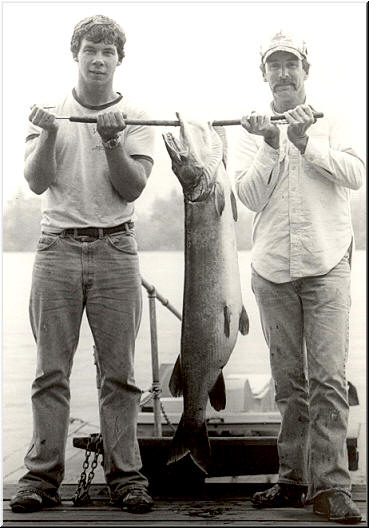
John Dettloff helping Al
Denninger lift his 40#er in 1984.
Finally, in
September of 1984, after much continued bad luck with his fishing, Al
relented and tossed a penny or two into the water for Chiz-ui-aw, sincerely
hoping that it would help him catch a nice musky. Low and behold, on that
very day, Al ended up catching a 40# plus musky! Naturally, that made a
believer out of Denninger.
In 1986, Pat built a beautiful log home overlooking the resort’s spacious
beach and, in 1988, began renting out its lower level as the resort’s deluxe
Beachfront Apartment and seventh rental “cottage”. In 1988, John married
Paulette and–along with Pat–ran the resort together for the next ten years.
A new kitchen was one of the first orders of business for the two and, upon
remodeling it in 1989, it was discovered that Chiz-ui-aw’s original cabin
lay hidden beneath its walls and was still completely intact. In 1999, John
and Paulette divorced.
During the spring of 2000, John discovered that–because of the age of the
building–the entire front of the bar had actually collapsed somewhat beneath
the weight of the dining room up above it. Upon tearing the siding off the
front of the bar, he learned that all of the vertical supports had rotted.
In what became his most challenging restoration project at the resort, the
bar was closed for the whole month of May that year while John focused on
this challenge.
Prior to dismantling not only the front end of the bar building but also the
entire pipestone patio–which had been breaking up with the repeated frosts
over the years–John took many photos and precise measurements of how
everything was originally put together so that he could accurately restore
it. Because the Little Red Bar and the patio have always been an important
part of the character at Indian Trail, John immersed himself in the project.
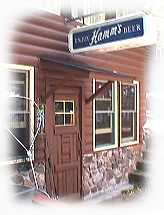 After re-supporting the dining room with steel supports that John had built
into the outer wall of the bar, he then reconstructed the outer stone wall
portion to its original dimensions, installed new windows in their original
configuration, and he even made an exact replica of the heavy, log bar
door. Because he had photographed and numbered all of the beautifully
varnished, log boards that were on the inside of the outer wall of the bar,
John was able to reassemble them in place so that nobody even knew that the
bar had been redone. After re-supporting the dining room with steel supports that John had built
into the outer wall of the bar, he then reconstructed the outer stone wall
portion to its original dimensions, installed new windows in their original
configuration, and he even made an exact replica of the heavy, log bar
door. Because he had photographed and numbered all of the beautifully
varnished, log boards that were on the inside of the outer wall of the bar,
John was able to reassemble them in place so that nobody even knew that the
bar had been redone.
When it came time to rebuilding the pipestone patio, John had taken the
hundreds of stones that it was made from and cleaned each of them off,
relaying them all in their original pattern. As a final touch to “age” the
concrete on the patio, John had a special mix of concrete made up, which
contained more aggregate, and at the precise time in the drying process
hosed off the surface cream to expose what looked to be an aged base of
concrete. Two local Indian boys worked very hard, wheeling all of the wet
concrete down the hill from the road to the patio… one wheel barrow at a
time. For the patio reconstruction project, John called upon Lance Boyle, a
Hayward mason and former high school acquaintance, to help him out.
It was at that time when John began dating Lance’s sister Brenda, who also
went to high school with John, and it wasn’t long before the two became
inseparable. After John introduced Brenda to the Flowage and his unique
world at Indian Trail, Brenda quickly became part of the resort. Brenda was
touched deeply by John’s respect for the serene beauty of the flowage, his
passion and dedication to the resort lifestyle, his personal care that he
shows his guests, and his intense love of the sport of musky fishing.
In July of 2002, John and Brenda were married at the site of the old Indian
Mission Church on Church Island, located just across the lake from the
resort. Because Brenda possesses
the same deep love for the Flowage, the outdoors, and the resort life that
John has, the pair is committed to ensuring that Indian Trail's character
and charm will never fade.
One important task that John and Brenda immediately saw to was the
refurbishment of the Bunkhouse. In addition to doing a complete repaint of
all the rooms and installing fresh carpeting, they also put in a roomy
shower and updated the front sitting room by adding a refrigerator and
microwave for the convenience of their guests. Also, because John and
Brenda know how important a good night’s sleep is, new mattresses were put
into whatever rooms needed them. Going even a step further, they named each
of the rooms after one of the old musky men from yesterday, with each room
paying tribute to a different angler. So right down to the brass numbers on
the doors of the rooms, the Bunkhouse at Indian Trail promises to serve as a
very quaint and inexpensive place of lodging for guests.
One reconstruction job in particular that John and Brenda really enjoyed
sinking their teeth into took place in 2006, when they rebuilt the stone
patio wall that winds its way down towards the lake. Over the years, part
of that wall had broken apart and it needed to be restored. Because Brenda
used to work with her brother and father–who were both masons–when she was
younger, she has experience working with concrete and isn’t one to mind
“getting her hands dirty.”
 A new tradition that was added to the resort in 2006 was the installation of
the musky bell just outside the “Little Red Bar.” While retaining the musky
siren for the few musky catches that are now kept and brought in, John and
Brenda felt it was important to acknowledge all of the released musky
catches that their guests were reporting by having them proudly ring the
musky bell every time they would catch a musky. Naturally, if someone
decides to bring in a trophy musky–or, better yet, a new worlds record
musky–we will be proud to ring the musky siren on anyone’s behalf… to let
the world know about the memorable event. A new tradition that was added to the resort in 2006 was the installation of
the musky bell just outside the “Little Red Bar.” While retaining the musky
siren for the few musky catches that are now kept and brought in, John and
Brenda felt it was important to acknowledge all of the released musky
catches that their guests were reporting by having them proudly ring the
musky bell every time they would catch a musky. Naturally, if someone
decides to bring in a trophy musky–or, better yet, a new worlds record
musky–we will be proud to ring the musky siren on anyone’s behalf… to let
the world know about the memorable event.
Other than adding a few more trailers to the trailer court in recent years,
there have been no major additions to Indian Trail during the past 23
years. This is by design, for John and Brenda feel that, in order to best
preserve the quaint ambiance that has always been unique to Indian Trail,
their primary focus will be the continued ongoing restoration and
preservation of Indian Trail Resort.
John and Brenda feel passionate about offering their guests a true
northwoods family/fishing resort experience… much in the tradition of the
classic resorts of a mostly bygone era. They feel it’s important to provide
their guests with a sanctuary to escape to from the modern world, a magical
place that reminds one of simpler times, and a place that will never run
short of creating special memories.
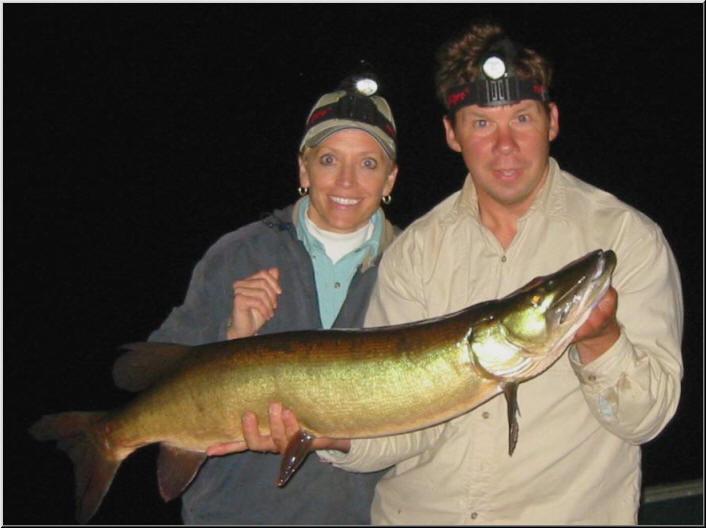
John and Brenda Dettloff,
2006.
John & Brenda Dettloff encourage couples to "take their
relationship to the next level" and enjoy the wonderful sport of
fishing together.
Late in 2007, John and Brenda bought out the remaining portion of the
original resort and Pat took a much deserved retirement that will enable her
to spend more time fishing and enjoying the lake.
This year Indian Trail
Resort proudly begins its 90th year in business and the 59th year for the Dettloff family.
John and Brenda are here to serve you and make your vacation as pleasurable
and memorable as possible.
|